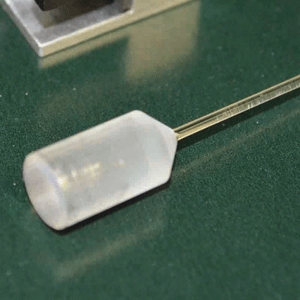
Specialty Splicing and Endcap Technology
AFLRequest Info
 As optical fiber processing technologies and specialty fiber research advances, an entirely new generation of fiber optic components has developed. With technologically-advanced high precision glass processing platforms, components such as ball lenses, tapers, combiners, endcaps and more can be produced at mass production quantities. Endcap technology has advanced with the emergence of high-powered fiber lasers. The energy density at the output end of a fiber laser can be extremely high. By using an endcap, high density energy can be allowed to diverge in a controlled manner. As light emerges, it is refocused onto the work surface with free-spaced optics. However, the endcap diameter can be 4 to 8 times larger than the actual fiber output from the laser. This poses a challenge for some heating methods used to fuse the fiber to the endcap.
As optical fiber processing technologies and specialty fiber research advances, an entirely new generation of fiber optic components has developed. With technologically-advanced high precision glass processing platforms, components such as ball lenses, tapers, combiners, endcaps and more can be produced at mass production quantities. Endcap technology has advanced with the emergence of high-powered fiber lasers. The energy density at the output end of a fiber laser can be extremely high. By using an endcap, high density energy can be allowed to diverge in a controlled manner. As light emerges, it is refocused onto the work surface with free-spaced optics. However, the endcap diameter can be 4 to 8 times larger than the actual fiber output from the laser. This poses a challenge for some heating methods used to fuse the fiber to the endcap.
By using a CO2 laser as the heat source, the CO2 laser works through absorption of photons into the silica which heats proportionally based on the surface area and thermal mass of the object being heated. Because the endcap has a much larger thermal mass than the smaller fiber connected to it, the two fibers heat at roughly the same rate when exposed to the energy from the CO2 laser. Therefore, CO2 lasers provide the most reliable splicing technology.
Learn more about AFL and its specialty splicing services at www.AFLglobal.com.
https://www.aflglobal.com
/Buyers_Guide/AFL/c397
REQUEST INFO ABOUT THIS PRODUCT
* First Name:
* Last Name:
* Email Address:
* Company:
* Country:
Message:
When you click "Send Request", we will record and send your personal contact information to AFL by email so they may respond directly. You also agree that Photonics Media may contact you with information related to this inquiry, and that you have read and accept our
Privacy Policy and
Terms and Conditions of Use.
Register or login to auto-populate this form:
Login
Register
* Required